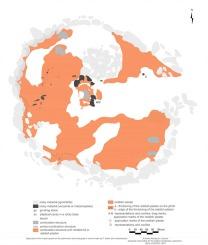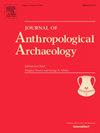Marks on the floor. Instant and memory in the foundation of an agro-pastoralist place in the Puna high desert, Northwest Argentina (ca. 1500 BP)
IF 2.2
1区 社会学
Q1 ANTHROPOLOGY
引用次数: 0
Abstract
A set of visual representations and marks made on the red plastered floor within a domestic enclosure, are analyzed. They belong to low scale agro-pastoralist societies that inhabited the Argentine Puna in the South Central Andes, ca. 1500 BP. The prepared floor would have configured a proper surface for a multisensory ritual performance. This type of material is reserved for specific places such as graves and offering deposits in the study area. The drawn visual representations are interpreted as to lineage emblems and, due to restricted visual access, they would pertain to the private sphere and therefore, would be aimed at communication within the social group. They are analyzed within the framework of ritual archaeology and feasting to propose that they could be part of the ritualization of the domestic place as an ordering element of the social group, and as a way of claiming the family territory. Shortly after its complex ritual closure, the enclosure was used for the confinement of Camelidae livestock. The ritual performance and the subsequent story of the enclosure in productive practices would have been significant actions in a context of environmental deterioration that could have affected the availability of fertile spaces in the region.

地板上有痕迹。阿根廷西北部普纳高原沙漠农牧地区基础的瞬间与记忆(约公元前1500年)
本文分析了一组在住宅围栏内的红色抹灰地板上的视觉表现和标记。他们属于大约公元前1500年居住在安第斯山脉中南部阿根廷普纳地区的小规模农牧社会。准备好的地板将为多感官仪式表演配置一个适当的表面。这种类型的材料是为特定的地方保留的,比如坟墓和研究区域的沉积物。绘制的视觉表征被解释为血统象征,由于视觉访问受限,它们将属于私人领域,因此将旨在社会群体内的交流。在仪式考古学和宴会的框架内对它们进行分析,提出它们可能是家庭场所仪式化的一部分,作为社会群体的秩序元素,作为一种声称家庭领土的方式。在其复杂的仪式关闭后不久,围栏被用于禁闭骆驼科牲畜。在环境恶化的背景下,仪式表演和随后的生产实践中的圈地故事将是重要的行动,可能会影响该地区肥沃空间的可用性。
本文章由计算机程序翻译,如有差异,请以英文原文为准。
求助全文
约1分钟内获得全文
求助全文
来源期刊

Journal of Anthropological Archaeology
Multiple-
CiteScore
4.00
自引率
11.10%
发文量
64
期刊介绍:
An innovative, international publication, the Journal of Anthropological Archaeology is devoted to the development of theory and, in a broad sense, methodology for the systematic and rigorous understanding of the organization, operation, and evolution of human societies. The discipline served by the journal is characterized by its goals and approach, not by geographical or temporal bounds. The data utilized or treated range from the earliest archaeological evidence for the emergence of human culture to historically documented societies and the contemporary observations of the ethnographer, ethnoarchaeologist, sociologist, or geographer. These subjects appear in the journal as examples of cultural organization, operation, and evolution, not as specific historical phenomena.
 求助内容:
求助内容: 应助结果提醒方式:
应助结果提醒方式:


